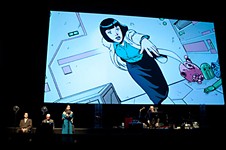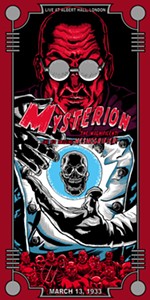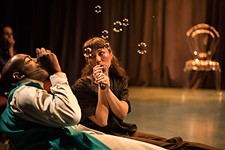Days of Future Past
The history of Salvage Vanguard Theater's unlikely sci-fi success, 'The Intergalactic Nemesis'
By Robert Faires, Fri., July 25, 2008
It was just supposed to be a spring fling.
Hip young theatre company that built its rep staging edgy contemporary dramas in bars flirts with old-fashioned radio serials in a coffee shop. Nobody involved had any high expectations for this lark of a show. It was going to be a few weeks, a few laughs, then a quick kiss goodbye. Yet here it is, 12 years later, and that show, The Intergalactic Nemesis, is still feeling the love. Salvage Vanguard Theater's affectionate spoof of the cliff-hangers of yesteryear, performed in the manner of a radio drama, with actors holding scripts in front of microphones and sound effects provided live by Foley artists, has become one of Austin's rare theatrical sensations: a hit with audiences from the first performance, which has had multiple revivals, spawned two sequels, and toured across the country. From a java joint that holds a few dozen people to theatrical palaces seating more than 2,000, The Intergalactic Nemesis has boldly gone where no play – at least no Austin-created play that sends up radio serials – has gone before. And to make matters stranger, it's a work of science fiction, a genre whose stage successes can pretty much be summed up by Karel Capek's R.U.R. and The Rocky Horror Show. If ever there were an unlikely theatrical hit, this would seem to be it. So what's the story?
Flashback to 1996: Tom Cruise, still years from using Oprah's couch as a trampoline, is enjoying boffo box office for Mission: Impossible, and the nation is afflicted with the musical virus called the "Macarena". On the local theatre scene, Salvage Vanguard Theater is winding up its second season at the Electric Lounge, where it has hooked up with its under-30 target audience and hooked them on plays. But despite that success, SVT artists are "looking to break out of the bars and spread to new nontraditional stages." So says Ray Colgan, the man everyone credits with the idea for The Intergalactic Nemesis. He says he was just trying to get plays on the tiny stagelike area in a Congress Avenue coffee shop. "The term 'Little Theatre in Little City' had popped into my head. Somehow that morphed into a radio serial."
A science-fiction radio serial, let's not forget. For SVT, whose work up to then had been all rock & roll and ragged edges, wasn't the pressed pants and pocket-protector geekiness of sci-fi a little out of character? Not according to company co-founder and Artistic Director Jason Neulander: "Those of us who were there at the beginning of SVT shared both a punk rock ethos – raw emotion, do-it-yourself, jagged edges – and a love for Star Wars and Raiders. So the common ground for the punk rock theatre thing and the radio adventure thing was a product of the time we grew up; punk rock and Star Wars were simultaneous phenomena for us impressionable kids."
Which may explain why Neulander liked the idea. He suggested that the piece be penned sitcom-style, with a team of writers mapping out the major arcs of the story and individual writers scripting specific episodes. "I came up with the characters," says Colgan, "and we came up with a plot arc with all the best things of serials: Nazis, fast-talking reporters, hypnotism, and aliens. The fun was going to be seeing how the different writers got us from point A to point B. Jason picked the writers, who came from different backgrounds."
The writing team was made up of Colgan, playwrights Lisa D'Amour (16 Spells to Charm the Beast) and Julia Edwards (Scavengers), and Jessica Reisman, who was in graduate school on a fiction fellowship. For Reisman, the draw was "an opportunity to do a different kind of writing and to work with other writers on something that sounded like a lot of fun, with elements that appealed to me. I've always read and written science fiction. The weekly installment structure gave a nice sense of excitement and urgency to the whole thing, too."
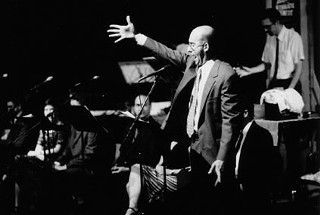
"Urgency" may be an understatement, given the schedule for the first Nemesis. The breathless, turn-on-a-Mercury-dime saga – librarian from the future Ben Wilcott drafts ace reporter Molly Sloan and sidekick Timmy Mendez to help him thwart evil extraterrestrials from conquering Earth – was mapped out over 10 15-minute episodes, but the episodes weren't finished before the production launched. In fact, the Nemesis scribes were writing on the fly throughout the five weeks of the first run. Two episodes were presented each Sunday, which meant that two of the writers had to crank out an episode each between Monday and Friday.
"We'd get scripts on Friday," says Neulander, "rehearse with the cast for a couple of hours on Saturday, talk about how the heck we were going to create the sound effects after that, run the sound effects at 4pm on Sunday, then race to Little City to set up the sound system and sound effects for a 7pm curtain. It's astounding that the show came together at all."
Chad Nichols, an actor in the first Nemesis and a writer on the sequels, remembers it as "a dizzying pace, especially for theatre. But it allowed you to be very loose and intuitive. It was great as an actor because you couldn't fixate on things; you just kind of had to go for the gusto. Buzz and Tony had the most interesting job, coming up with the sound effects. Every week the script posed a kind of logistical puzzle for them, and their solutions could be incredibly creative. Rehearsals were like our own private episode of MacGyver. You know, 'Pass me that pickle bucket and a plunger.'"
Tony was Tony Nozero, a drummer who was asked to provide the show's live sound effects, and Buzz was Buzz Moran, who was asked by Nozero to help. "I had always played around with getting sounds from nonmusical objects. I was a big fan of radio shows and science fiction," says Moran. "When I found out that the show would take a ton of time and pay nothing, I was hooked."
He learned quickly that sound wasn't just a casual element of the show. "The writers were all really excited to have sound effects, so they added as many as they could possibly think of in every episode," Moran says. "We would be given the scripts for the week's episodes the day before the show, and that was all the time we had to find and practice using all the things asked for in the script. Imagine having one day to find out the sound of a 'mind whammy,' a 'robot army,' or a 'Zygonian decoction chamber,' keeping in mind that you will be responsible for performing the sound in front of a large crowd the next day. The hardest thing was figuring out how to make everyday sounds without any resources or time. Footsteps on a wooden floor, a taxicab in transit, a jail-cell door slamming shut. There was a lot of adrenaline flowing during that time."
"My most vivid memories of the project were rehearsals, which were at Tony and Buzz's house," says Julia Edwards. "We packed a cast of actors, a few writers, lots of gadgets, and the sound guys into a tiny living room, and there was no air conditioning. So I remember lots of creativity, invention, humor, and sweat. Which I think sums up art in Austin pretty well."
The trick, though, is finding an audience in Austin for all that humor, invention, and creativity. Many a local production has struggled to draw just a handful of theatregoers, and one might have expected an experiment in retro sci-fi performed on Sunday nights in a coffee shop to have done so. But somehow that was not the case. "The first week, we could not fit everyone who wanted to see it into the space," says Neulander, who was floored. "I'm not sure if we even sent out a postcard; the only way to find out about it was word of mouth."
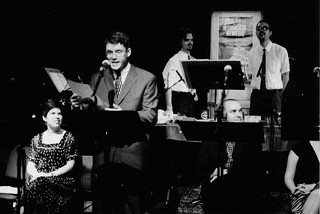
Moran was amazed not only by the size of the crowd but also by how "rowdy and appreciative" they were. "It might have helped that the show was free, but nobody was telling them to scream and applaud so loudly. Actually, we did tell them to scream and applaud loudly, but they certainly didn't have to oblige us."
About the only thing more surprising than all the people who packed Little City for The Intergalactic Nemesis' first night was all the people who kept packing it week after week. "I didn't think that many people would come out for it, but people came," says Colgan, "and kept coming, even though the episodes were too long, horribly paced, didn't make much sense, and were in no way even close to being done as smoothly as they are now. Our beloved Foley artists were teaching themselves Foley art week to week. It was very, very amateur, but people still seemed to enjoy it."
For Neulander, it didn't take much of seeing that enjoyment to know they'd caught lightning in a Klein Bottle. "After that first week, I realized we had stumbled onto something," he says. "I told Ray that we needed to play the Paramount – that even if it took 10 years, we needed to stick with this because we had tapped into something big."
Though that performance at the Paramount actually took 12 years to happen, Neulander was right about the show. The Intergalactic Nemesis continued to find success. The Little City performances, which had been recorded, made the leap to radio, getting a run in true serial form on KUT's Soundsight program in 1997. Three years later, Moran approached Neulander about condensing the serial into an evening-length piece of theatre. ("My thought was that I could finally get paid for my work on the show," he says. "We put it back together and performed it at the State Theatre for an excited, sold-out audience, and I still didn't get paid.") The success at the State prompted Neulander and Colgan to develop the first sequel, Return of the Intergalactic Nemesis, the next year. That led to a production of the original and the sequel in repertory in 2002 and to the idea of taking the show on the road. A possible tour that summer fell through, but at a conference on touring theatre in 2004, Neulander met Christine Tschida of the national arts management firm Rena Shagan Associates – "She had been the producer of A Prairie Home Companion and completely 'got it,'" he says – which led to The Intergalactic Nemesis getting booked around the country. In 2006, a year after the second sequel, Intergalactic Nemesis: Twin Infinity, was produced, Salvage launched its first national tour with a performance in the 1,200-seat Hogg Auditorium on the University of Texas campus. Nemesis continues to get bookings, and now that he has stepped down as Salvage Vanguard artistic director, Neulander is putting extra energy into the show, working on a commercial production for New York, a new website, and a graphic novel with Austin comic artist Tim Doyle. "Nemesis has grown to a scale that I wouldn't really have dreamed of when we created it," says Neulander. "Touring to 25 cities and towns, playing venues from 400 to 2,200 seats. It's unbelievable to me."
And how does one explain all this success? Does it have anything to do with science fiction? Ray Colgan isn't convinced. "The writing was so quick and unplanned; you were given last week's script and told what needed to happen by the end of yours, and you just busted it out. Since that somehow connected with people, it seems like any genre would have worked as long as you were willing to throw every absurd thing you could into the mix and play with every cliché of that genre."
Julia Edwards is inclined to agree: "I'm a big sci-fi geek, but I think the project would have succeeded if it was adventure or mystery. There's so little sci-fi in theatre, though – and perhaps the reason the radio idea worked so well was we could tap into the collective imaginations of the audience members to fill in the intergalactic pictures. I think the true attraction was watching the Foley artists smash, whirl, and clang whatever was in sight."
That's an idea that resonates with Chad Nichols: "The overarching thing that has always kept people interested in this show is the Foley. By having the Foley artists visible, the audience has this constant sense of discovery: 'Oh, that's how that's done. How inventive.' Conceptually, what the sci-fi angle did was open up possibilities. Once the characters were in space, the writers could do just about whatever they wanted. And so could the Foley artists. When they weren't anchored to familiar sounds, they could have a lot more latitude in designing the different effects. That's when the show started to feel like a real sci-fi serial."
Jessica Reisman, though, sees the retro sci-fi in Nemesis as being compatible with both the larger audience and the format: "That kind of science fiction – gosh-wow, anything-is-possible, hand-waving, fun gizmo [sci-fi] – is very appealing to both kids and a lot of adults who are still mourning the lost future they were promised by early [sci-fi] – flying cars, rocket packs, and [faster than light] – and aren't so engaged by the future we're living, which is more about information technology and biology. Also, I think space-adventure [sci-fi] might just be a better fit with the medium of the radio play and the historical context it harkens back to."
Buzz Moran agrees that history figures in, but he believes that The Intergalactic Nemesis wouldn't have gone as far as it has without the imaginative thrust of its chosen genre. "There is something about science fiction that sets it apart from regular monster or adventure stories. There is the possibility that anything can happen, that even accepted science needn't be followed," he says. "But when making something that is an homage to science fiction of the distant past, that explanation gets a little strange. There is something enticing about the way the future was viewed in the past. I can't get enough of the look of robots from the 1950s and earlier, but I hate the look of modern robots. I'll take Robbie over a Transformer any day, and I think it's a love of the archaic, outdated design of yesterday's cutting-edge technology. The Intergalactic Nemesis fits well into that idea: an antiquated entertainment form, the radio drama, about a future that you completely picture in your mind, although you are coerced to picture that future through vintage glasses. My kind of contradiction."
Besides, he notes, SVT did try another kind of genre radio drama, a slightly supernatural, hard-boiled detective story called Song of Evil. "The audiences were there, but it just never took off," he says. "It was missing the lure of outer space."






